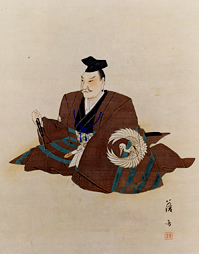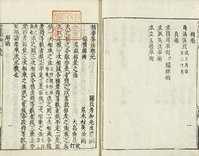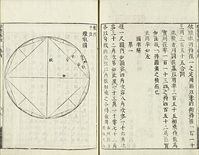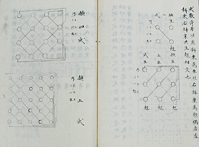Chapter 2. Seki Takakazu
This chapter introduces Seki Takakazu (?-1708), a famous Wasan scholar. People in those days, of course, had no idea of his legacy, but he performed great work as a representative scholar of Japan around the middle of the Edo period.
(1) Character and his times
Seki Takakazu 's year of birth was unknown, but it is known that he died in 1708. He spent most of his career serving the Tokugawa family in the Koshu Domain as a bureaucrat whose specialty was accounting, and his social position became that of a shogunate retainer because his feudal lord became the successor (later the sixth shogun Tokugawa Ienobu) to the fifth shogun (hereditary military dictator of Japan), but soon after that he retired from public life. This is all that is known to us now about his public life. Considering his reputation as a mathematician, few of his deeds have been passed down.
His contemporaries as men of letters were Chikamatsu Monzaemon and Matsuo Basho. As a political incident, he must have known about the raid into Kira's mansion by the 47 ex-retainers of Lord Asano from the Ako Domain through the news of his time, and he would have been bound by the infamous Edicts on Compassion for Living Things since he lived at the time of the fifth shogun Tokugawa Tsunayoshi.
Famous international contemporaries of his included Newton (1642-1727) and Leibniz (1646-1716), mathematicians from England and Germany respectively. For this reason, the mathematics of Seki Takakazu was introduced in parallel with the founders of calculus. Needless to say these figures did not know each other and we cannot find any evidence of the introduction of calculus to Japan at that time via Holland. It is also often said that Seki's mathematics had reached the level of calculus, but although we can find some similar formulae, the Wasan of that time and calculus were based on totally different concepts, when viewed as a whole, and therefore we should avoid simple comparisons between them.

Seki Takakazu
Owned by Koju Kai and kept by Imizu City Shinminato Museum
(2) His writings and disciples
Seki published only one piece of writing in his life. The book is called Hatsubi sanpo, which gave solutions to 15 idai questions from Kokon sanpoki by Sawaguchi Kazuyuki. In addition to this, Seki left many other works: Katsuyo sanpo as his typical work was published by his disciples after his death, while other works such as Kaifukudai no ho were passed down as handwritten duplicate copies among his disciples. In the mathematical context, they approached such a wide variety of problems that we could even assume that they covered the most of the problems that could be imagined in those days.
It is known to us that Seki had several disciples. The two most famous disciples were Araki Murahide, involved in publishing Katsuyo sanpo, and Takebe Katahiro (1664-1739), the hatamoto of the shogunate (samurai who guarded the camp of the shogun in feudal Japan), who was later given an important position by Tokugawa Yoshimune. Takebe, in particular, not only played the role of passing on Seki's mathematical research results to future generations by publishing Hatsubi sanpo endai genkai (a handbook for Hatsubi sanpo by Seki Takakazu), compiling Taisei Sankei, a great library of books that was designed to be a summarization of their mathematical knowledge, etc., but he also left Tetsujutsu sankei in which he compiled his own mathematical techniques. After Seki's death, we find a person called Nakane Genkei (1662-1733) in Kyoto, who performed research in cooperation with Takebe Katahiro. It was Nakane who created the opportunity to convey Seki's research results to Kyoto and have a few Wasan books by Seki published at bookstores in Kyoto (Tennojiya Ichirobe).

Katsuyo sanpo
Library of Katsuyo sanpo
NDL Digital Collections
(3) Accomplishments
Seki left a wide range of accomplishments, among which, as those that had a great impact on future generations, we could select the development of his unique notation (boshoho) and the dramatic improvement of tengenjutsu (tian yuan shu) by expressing mathematical formulae at will using the notation ("Kaifukudai no ho"). In simple terms, boshoho was designed to make it possible to express alphanumeric characters in a single expression, improving the ability to describe mathematical expressions in Wasan.
This helped to add applications to tengenjutsu. The first tengenjutsu introduced from China could only address equations with one unknown quantity. Introducing mathematical expressions with boshoho enabled more than one unknown quantity to be described in one expression, thus simplifying the process of mathematical expressions. In modern mathematical terms, boshoho made it easier to eliminate the unknown quantities in simultaneous equations. Seki applied this tengenjutsu to problems in various fields. For example, he actually demonstrated examples of calculating the areas of regular polygons, ranging from equilateral triangles to regular 20 sided polygons in Katsuyo sanpo .
The appearance of the new type of mathematics by Seki Takakazu afforded great benefits to future Wasan scholars. Those benefits were that the mathematical expressions were made very simple, that the solutions to problems were made more predictable, that new types of formulas were developed, and so on. By the second half of the eighteenth century, Seki's name had spread among Wasan scholars to such a degree that he was even sometimes referred to as "Sansei" (san means mathematics and sei means sage) after Matsuo Basho (Haisei (hai means haiku and sei means sage)) in Haiku, and Sen'no Rikyu (Chasei (cha means tea ceremony and sei means sage)). It was after the second half of the eighteenth century that Wasan scholars belonging to the line of Seki Takakazu started to call their own group the "Seki school." The next chapter will introduce some of the organizations in which such Wasan scholars were performing their research activities.

Calculates Pi using polygons inscribed within a circle
Library of Katsuyo sanpo
Katsuyo sanpo
NDL Digital Collections
One of a series of manuscripts that describe solutions to equations by Seki Takakazu. The picture shows a section for describing how to calculate a determinant.
Lager image for Kaifuku dai no ho
Kaifuku dai no ho (owned by the University of Electro-Communications)


